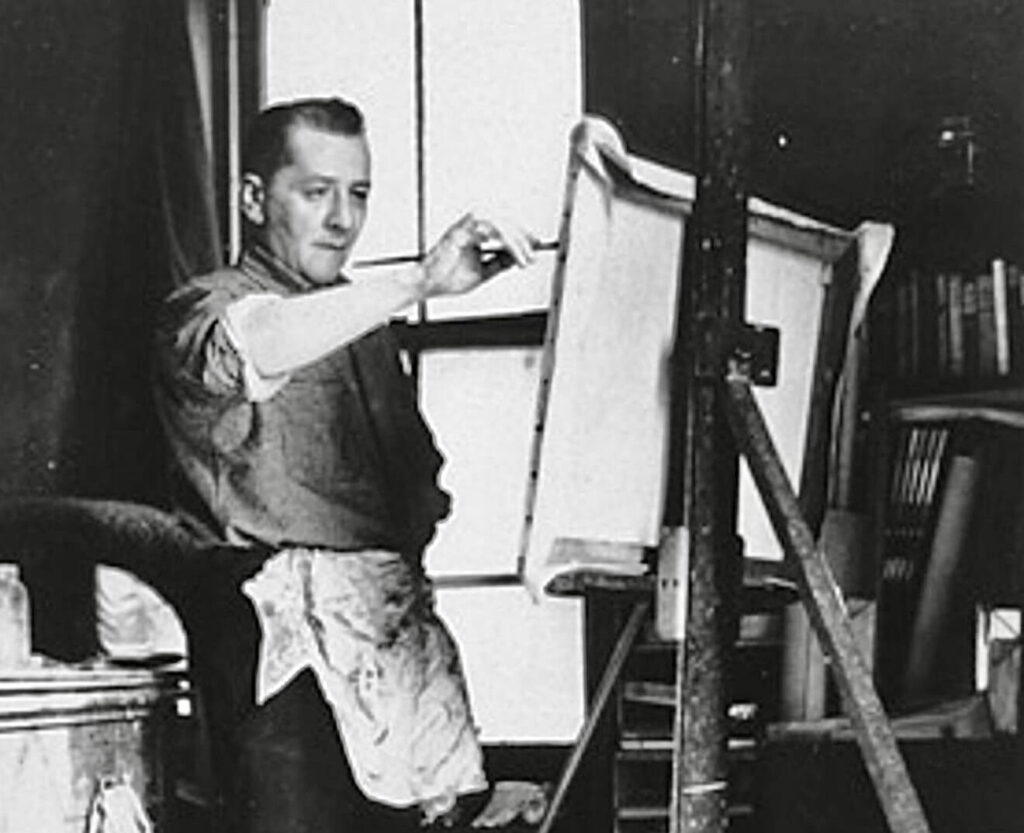William Baziotes
William Baziotes (1912-1963) was a key figure in the Abstract Expressionist movement, known for his ethereal, enigmatic paintings that blend surrealism, abstraction, and a deep sense of poetic mystery. His work often features biomorphic forms and dreamlike imagery, reflecting his interest in the unconscious mind and the exploration of inner landscapes.

Early Life and Education
William Baziotes was born on June 11, 1912, in Pittsburgh, Pennsylvania, to Greek immigrant parents. His family moved to Reading, Pennsylvania, where he grew up. From a young age, Baziotes showed a keen interest in art, which was encouraged by his family and teachers. After high school, he worked at a glass factory, where he began experimenting with drawing and painting in his spare time.
In 1933, Baziotes moved to New York City to study at the National Academy of Design. Here, he received a traditional art education, learning classical techniques and studying the works of Old Masters. However, he soon became interested in modern art movements, particularly surrealism, which would profoundly influence his future work.
Artistic Influences and Early Career
Baziotes’ early work was heavily influenced by surrealism and the writings of poets and philosophers such as Charles Baudelaire and Sigmund Freud. He was particularly drawn to the surrealist emphasis on the unconscious mind and the exploration of dreamlike imagery. During this time, he also met and befriended several prominent artists, including Robert Motherwell, Jackson Pollock, and Mark Rothko, who would become key figures in the Abstract Expressionist movement.
In the late 1930s, Baziotes joined the Works Progress Administration (WPA) Federal Art Project, where he worked alongside other emerging artists and gained valuable experience. His involvement with the WPA provided him with financial stability and opportunities to exhibit his work. It was during this period that Baziotes began to develop his unique style, blending surrealist techniques with abstract forms.
Transition to Abstract Expressionism
By the early 1940s, Baziotes had begun to move away from overt surrealist influences and towards a more abstract, expressionist style. His work became increasingly focused on the exploration of inner landscapes and the evocation of emotional states. Baziotes’ paintings from this period are characterized by their use of biomorphic forms, muted color palettes, and a sense of poetic mystery.
One of Baziotes’ most significant contributions to the Abstract Expressionist movement was his emphasis on the process of painting as a means of accessing the unconscious mind. He believed that the act of painting could be a form of meditation, allowing the artist to tap into deeper layers of the psyche. This approach aligned with the broader aims of Abstract Expressionism, which sought to break away from traditional forms of representation and explore new ways of expressing emotion and inner experience.
Important Artwork: “The Dwarf” (1947)
One of William Baziotes’ most celebrated works is “The Dwarf” (1947). This painting exemplifies his mature style and his ability to blend abstraction with surrealist influences.
“The Dwarf” (1947)
“The Dwarf” is a striking example of Baziotes’ ability to create enigmatic, dreamlike compositions. The painting features a central, biomorphic form that appears to be part human, part creature, set against a muted, abstract background. The figure’s ambiguous, fluid shape and the subdued color palette create a sense of mystery and unease.
The central form in “The Dwarf” is characterized by its elongated, undulating lines and organic shapes, reminiscent of the work of Joan Miró and André Masson. The figure seems to float in a liminal space, neither fully grounded nor entirely abstract. This ambiguity invites viewers to project their own interpretations onto the work, engaging with it on a subconscious level.
Baziotes’ use of color in “The Dwarf” is subtle and restrained, with a focus on muted tones of blue, green, and brown. These colors create a sense of calm and introspection, drawing the viewer into the painting’s contemplative mood. The soft, diffused light adds to the dreamlike quality of the work, enhancing its otherworldly atmosphere.
“The Dwarf” reflects Baziotes’ interest in mythology, the unconscious mind, and the exploration of inner landscapes. The painting’s title suggests a connection to folklore and fantasy, adding another layer of meaning to the work. By combining abstract forms with surrealist imagery, Baziotes creates a powerful and evocative composition that continues to resonate with viewers.
Later Career and Legacy
In the 1950s, Baziotes’ work continued to evolve, becoming more refined and focused. He experimented with new techniques and materials, including the use of sand and other textural elements in his paintings. His compositions became more simplified and abstract, with an increased emphasis on color and form.
Despite his growing reputation, Baziotes struggled with health issues throughout his career, which affected his productivity and ability to exhibit his work. Nevertheless, he remained committed to his artistic vision and continued to create innovative and evocative paintings.
Baziotes’ contributions to the Abstract Expressionist movement were recognized by his peers and by art critics. He exhibited in numerous group shows and had several solo exhibitions, including at the Samuel M. Kootz Gallery in New York. His work was also included in major exhibitions such as the Whitney Annual and the Venice Biennale.
William Baziotes passed away on June 6, 1963, at the age of 50. Despite his relatively short career, he left a lasting impact on the art world. His unique approach to abstraction, blending surrealist influences with a focus on the unconscious mind, set him apart from his contemporaries and established him as a key figure in the Abstract Expressionist movement.
Legacy and Influence
William Baziotes’ work continues to be celebrated for its poetic and enigmatic qualities. His paintings are held in major museum collections, including the Museum of Modern Art in New York, the Whitney Museum of American Art, and the Guggenheim Museum. Baziotes’ influence can be seen in the work of contemporary artists who explore themes of abstraction, mythology, and the unconscious mind.
- Influence on Abstract Expressionism: Baziotes was a key figure in the development of Abstract Expressionism, contributing to the movement’s emphasis on the exploration of inner landscapes and the emotional power of abstract forms. His work helped to define the movement and expand its expressive possibilities.
- Impact on Subsequent Generations: Baziotes’ innovative approach to abstraction and his exploration of the unconscious mind have influenced subsequent generations of artists. His emphasis on the meditative process of painting and the creation of dreamlike compositions continues to resonate with contemporary artists exploring the boundaries of abstraction.
- Continued Relevance: Baziotes’ work remains relevant and celebrated in the art world, with his paintings held in major museum collections worldwide. His influence can be seen in the work of contemporary artists who explore themes of abstraction, mythology, and the unconscious mind.
Conclusion
William Baziotes’ artistic journey is a testament to his dedication to exploring the depths of abstraction and his relentless pursuit of artistic authenticity. Through his innovative techniques and distinctive style, Baziotes pushed the boundaries of Abstract Expressionism and left an indelible mark on the history of modern art. His notable work, “The Dwarf,” exemplifies his mastery of color, form, and composition, highlighting his unique approach to abstract painting.
In celebrating William Baziotes’ life and work, we recognize his significant contributions to the development of Abstract Expressionism and his enduring legacy as a pioneer of abstract art. His paintings continue to inspire and captivate, reminding us of the power of art to evoke profound emotions and push the boundaries of human creativity.



